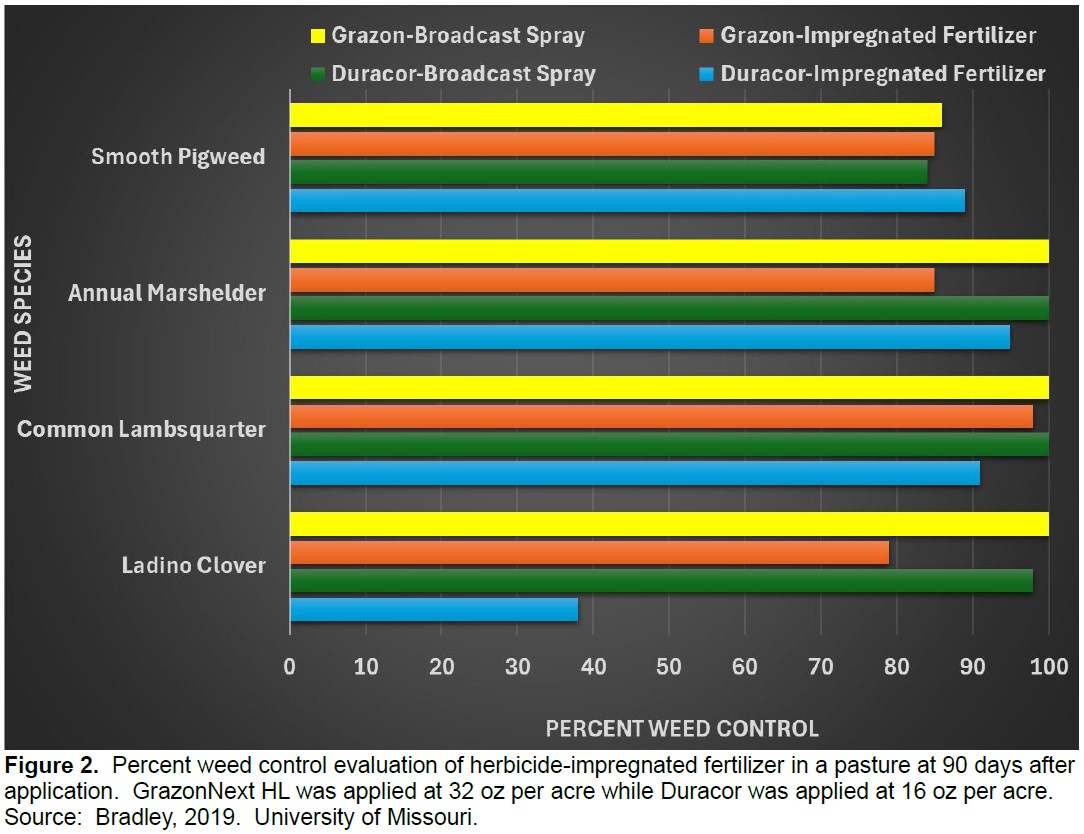The Use of Fertilizer Impregnated with Herbicide in Your Pasture or Hayland
Authors
Extension/Research Professor
Forage Establishment, Grazing Systems and Management, Hay Production, Forage Fertility, Forage Quali
The rise in fertilizer and herbicide prices has prompted livestock producers for alternative methods to reduce application costs by combining the application of fertilizer and herbicide at the same time. To achieve this strategy, the granular herbicide is coated with a concentrated herbicide solution at blending to manage targeted weeds. This approach could minimize the risk of drift, save time and application costs with only one trip, and improve applications in areas where is difficult to use a sprayer such as a new cutoff area.
Before the application of any herbicide, producers need to consider several key factors such as weed identification (know the species), growth habit (size, annual, perennial, etc.), timing or window of application (growth habit vs weed emergence, Figure 1), and herbicide and rate selection (depending on weed growth size).

The strategy of fertilizer impregnated with herbicide is limited to a few herbicides such as GrazonNext® HL (2,4- + aminopyralid) and Duracor® (aminopyralid +florpyrauxifen-benzyl). Both products are labeled for fertilizer impregnation in the southeast (AL, AR, FL, GA, LA, and MS) under the FIFRA 2 (ee) recommendation. Double-check the label for sale and use in your state. GrazonNext HL should be applied at a rate of 2 to 2.1 pints per acre while Duracor should be applied at a rate of 16 to 20 ounces per acre. To obtain a uniform rate of application, there is a recommendation of 200 pounds of fertilizer per acre as a carrier. Weeds should also be treated when they are less than six inches tall. Make sure that you take a soil sample and that the soil test recommendation reflects the need for fertilizer applications before implementing this practice and to justify the extra cost of fertilizer involved with using this weed control management practice. The herbicide-impregnated fertilizer must be treated with a dye to state the presence of an herbicide in the product. Keep in mind that the mixing and application equipment must be dedicated for use on hay and pastureland only to limit off-target application, which limits the capability of commercial fertilizer applicators.
Some of the factors that can have a detrimental impact on the uniformity of this strategy include properly calibrated fertilizer spreader and soil moisture. GrazonNext is a soil-active herbicide, and it will need to be absorbed by the weeds through the root system (Figure 2). Due to these mechanisms, the expectations of weed control should be less compared to a foliar application. The herbicide efficacy will depend on rainfall and at least 0.25 inches of rain within 30 days of application might be necessary. Under, the hot and humid conditions, there is also the need to consider fertilizer volatilization as another factor.

Although GrazonNext and Duracor do not have grazing restrictions, it is recommended to let the herbicide start moving into the soil for at least three days before resuming grazing. Keep in mind that GrazonNext and Duracor can also cause injury to clover species. Pay attention to the label restrictions related to planting, hay harvested for sale off the farm, and the application of manure to sensitive crops.
The data on impregnating fertilizer with an herbicide for pasture and hay production is limited and more data is needed to make a proper recommendation and guidelines on how to implement this farm management approach. This is a great tool to have in the toolbox but might not be the right fit for every acre of pastureland in your farm.